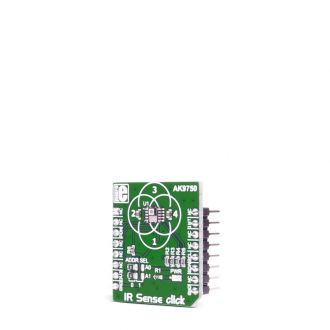
We strongly encourage users to use Package manager for sharing their code on Libstock website, because it boosts your efficiency and leaves the end user with no room for error. [more info]

Rating:
Author: MIKROE
Last Updated: 2019-04-22
Package Version: 1.0.0.1
mikroSDK Library: 1.0.0.0
Category: Temperature & humidity
Downloaded: 6369 times
Not followed.
License: MIT license
IR Sense click carries the AK9750 quantum-type IR sensor. The click is designed to run on a 3.3V power supply. It communicates with the target microcontroller over I2C interface, with additional functionality provided by the INT pin on the mikroBUSâ„¢ line.
Do you want to subscribe in order to receive notifications regarding "IR Sense click" changes.
Do you want to unsubscribe in order to stop receiving notifications regarding "IR Sense click" changes.
Do you want to report abuse regarding "IR Sense click".

Library Description
The library covers all the necessary functions to control IR Sense Click board. Library performs the communication with the device via I2C driver by writing to registers and by reading from registers. The library has generic write and reads function, get temperature data from the register, set configuration function, get the value of sensor channel 1, 2, 3 and 4, set the mode, set the cutoff frequency, etc.
Key functions:
Examples description
The application is composed of three sections:
void applicationTask()
{
if ( irsense_checkAvailable() )
{
irsense_getIRSense( &bottomArea, &leftArea, &rightArea, &topArea );
mikrobus_logWrite( "- - - - - - - - -", _LOG_LINE );
IntToStr( bottomArea, logText );
mikrobus_logWrite( " Bottom :", _LOG_TEXT );
mikrobus_logWrite( logText, _LOG_LINE );
IntToStr( leftArea, logText );
mikrobus_logWrite( " Left :", _LOG_TEXT );
mikrobus_logWrite( logText, _LOG_LINE );
IntToStr( topArea, logText );
mikrobus_logWrite( " Top :", _LOG_TEXT );
mikrobus_logWrite( logText, _LOG_LINE );
IntToStr( rightArea, logText );
mikrobus_logWrite( " Right :", _LOG_TEXT );
mikrobus_logWrite( logText, _LOG_LINE );
mikrobus_logWrite( "- - - - - - - - -", _LOG_LINE );
temperature = irsense_getTemperature();
FloatToStr( temperature, logText );
mikrobus_logWrite( " Temperature: ", _LOG_TEXT );
mikrobus_logWrite( logText, _LOG_TEXT );
mikrobus_logWrite( degCel, _LOG_LINE );
mikrobus_logWrite( "---------------------------", _LOG_LINE );
irsense_refresh();
Delay_1sec();
}
}
Other mikroE Libraries used in the example:
I2CUART​ConversionAdditional notes and informations
Depending on the development board you are using, you may need USB UART click, USB UART 2 click or RS232 click to connect to your PC, for development systems with no UART to USB interface available on the board. The terminal available in all MikroElektronika compilers, or any other terminal application of your choice, can be used to read the message